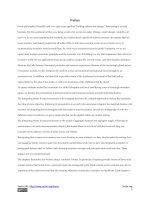Principles of macroeconomics 10e by case fair oster ch21
Bạn đang xem bản rút gọn của tài liệu. Xem và tải ngay bản đầy đủ của tài liệu tại đây (769.05 KB, 35 trang )
PRINCIPLES OF
MACROECONOMICS
PART V The World Economy
TENTH
EDITION
CASE FAIR OSTER
© 2012 Pearson Education, Inc. Publishing as Prentice Hall
Prepared by: Fernando Quijano & Shelly
1 ofTefft
35
PART V The World Economy
© 2012 Pearson Education, Inc. Publishing as Prentice Hall
2 of 35
Economic Growth in
Developing and
Transitional
Economies
21
CHAPTER OUTLINE
Life in the Developing Nations: Population and
Poverty
Economic Development: Sources and Strategies
The Sources of Economic Development
Strategies for Economic Development
Two Examples of Development: China and India
PART V The World Economy
Development Interventions
© 2012 Pearson Education, Inc. Publishing as Prentice Hall
Random and Natural Experiments: Some New Techniques in
Economic Development
Education Ideas
Health Improvements
Population Issues
The Transition to a Market Economy
Six Basic Requirements for Successful Transition
3 of 35
All economic analysis deals with the problem of making choices under conditions
of scarcity, and the problem of satisfying people’s wants and needs is as real for
Somalia and Haiti as it is for the United States, Germany, and Japan.
The universality of scarcity is what makes economic analysis relevant to all
nations, regardless of their level of material well-being or ruling political ideology.
PART V The World Economy
Even though economic problems and the policy instruments available to tackle
them vary across nations, economic thinking about these problems can be
transferred easily from one setting to another.
© 2012 Pearson Education, Inc. Publishing as Prentice Hall
4 of 35
Life in the Developing Nations: Population and Poverty
TABLE 21.1 Indicators of Economic Development
Country
Group
Literacy Rate
(percent over
15 years
of age)
114
Internet
Users per
1,000 People,
2005
Low-income
2.4 billion
650
60.8
Lower middleincome
2.3 billion
1,778
88.9
39.8
86
Upper middleincome
810 million
5,913
93.1
29.9
194
1.0 billion
36,487
98.7
6.9
523
High-income
PART V The World Economy
Population,
2006
Gross
National
Income per
Capita,
2006
(dollars)
Infant
Mortality,
2006
(deaths
before age
5 per 1,000
births)
44
While the developed nations account for only about one-quarter of the world’s
population, they are estimated to consume three-quarters of the world’s output.
This leaves the developing countries with about three-fourths of the world’s
people but only one-fourth of the world’s income.
The simple result is that most of our planet’s population is poor.
© 2012 Pearson Education, Inc. Publishing as Prentice Hall
5 of 35
PART V The World Economy
Developing nations account for____of the world’s population and
consume____of the world’s output:
a.
1/4; 3/4.
b.
3/4; 1/4.
c.
4/5; 1/5.
d.
1/2; 1/2.
© 2012 Pearson Education, Inc. Publishing as Prentice Hall
6 of 35
PART V The World Economy
Developing nations account for____of the world’s population and
consume____of the world’s output :
a.
1/4; 3/4.
b.
3/4; 1/4.
c.
4/5; 1/5.
d.
1/2; 1/2.
© 2012 Pearson Education, Inc. Publishing as Prentice Hall
7 of 35
Economic Development: Sources and Strategies
The Sources of Economic Development
Capital Formation
vicious-circle-of-poverty hypothesis Suggests that
poverty is self-perpetuating because poor nations are
unable to save and invest enough to accumulate the
capital stock that would help them grow.
PART V The World Economy
capital flight The tendency for both human capital and
financial capital to leave developing countries in search of
higher expected rates of return elsewhere with less risk.
© 2012 Pearson Education, Inc. Publishing as Prentice Hall
8 of 35
PART V The World Economy
The vicious cycle of poverty is an explanation of poverty that
emphasizes:
a.
Income distribution and wealth accumulation.
b.
Hunger, illiteracy, and malnutrition.
c.
Consumption, saving, investment, and capital accumulation.
d.
Agriculture versus industry and imports versus exports.
© 2012 Pearson Education, Inc. Publishing as Prentice Hall
9 of 35
PART V The World Economy
The vicious cycle of poverty is an explanation of poverty that
emphasizes:
a.
Income distribution and wealth accumulation.
b.
Hunger, illiteracy, and malnutrition.
c.
Consumption, saving, investment, and capital
accumulation.
d.
Agriculture versus industry and imports versus exports.
© 2012 Pearson Education, Inc. Publishing as Prentice Hall
10 of 35
Economic Development: Sources and Strategies
The Sources of Economic Development
Human Resources and Entrepreneurial Ability
brain drain The tendency for talented people from
developing countries to become educated in a
developed country and remain there after graduation.
PART V The World Economy
Social Overhead Capital
social overhead capital Basic infrastructure projects
such as roads, power generation, and irrigation systems.
© 2012 Pearson Education, Inc. Publishing as Prentice Hall
11 of 35
PART V The World Economy
Which of the following statements is correct?
a.
Poverty alone cannot explain capital shortages, and poverty is not
necessarily self perpetuating.
b.
Development cannot proceed without human resources capable of
initiating and managing economic activity.
c.
The governments of developing countries can do important and
useful things to encourage development, especially in areas that
the private sector would never touch.
d.
All of the above statements are correct.
© 2012 Pearson Education, Inc. Publishing as Prentice Hall
12 of 35
PART V The World Economy
Which of the following statements is correct?
a.
Poverty alone cannot explain capital shortages, and poverty is not
necessarily self perpetuating.
b.
Development cannot proceed without human resources capable of
initiating and managing economic activity.
c.
The governments of developing countries can do important and
useful things to encourage development, especially in areas that
the private sector would never touch.
d. All of the above statements are correct.
© 2012 Pearson Education, Inc. Publishing as Prentice Hall
13 of 35
E C O N O M I C S I N PRACTI C E
Corruption
Many people have argued that one
barrier to economic development in a
number of countries is the level of
corruption and inefficiency in the
government.
PART V The World Economy
One reason corruption is bad for an
economy is that it often leads to the
wrong firms, the less efficient firms,
producing the goods and services in the
society.
The chart shows the World Bank’s rating
of corruption levels in a number of
countries around the world.
The countries are ranked from those with
the strongest controls on corruption—
Germany and France—to those with the
lowest controls—Pakistan and Nigeria.
© 2012 Pearson Education, Inc. Publishing as Prentice Hall
14 of 35
Economic Development: Sources and Strategies
Strategies for Economic Development
Governments or Markets?
PART V The World Economy
International Monetary Fund (IMF) An
international agency whose primary goals are
to stabilize international exchange rates and to
lend money to countries that have problems
financing their international transactions.
World Bank An international agency that
lends money to individual countries for projects
that promote economic development.
industrial policy A policy in which
governments actively pick industries to support
as a base for economic development.
© 2012 Pearson Education, Inc. Publishing as Prentice Hall
15 of 35
Economic Development: Sources and Strategies
Strategies for Economic Development
Agriculture or Industry?
TABLE 21.2 The Structure of Production in Selected Developed and Developing
Economies, 2008
Country
Per-Capita
Gross National
Income (GNI)
Agriculture
Industry
Services
440
45
17
38
520
19
29
52
China
2,940
11
49
40
Thailand
3,670
12
44
44
Columbia
4,620
9
36
55
Brazil
7,300
7
28
65
Korea (Rep.)
21,530
3
37
60
Japan
38,130
1
29
70
United States
47,930
1
22
77
Tanzania
$
Bangladesh
PART V The World Economy
Percentage of Gross Domestic Product
© 2012 Pearson Education, Inc. Publishing as Prentice Hall
16 of 35
Economic Development: Sources and Strategies
Strategies for Economic Development
Exports or Import Substitution?
import substitution An industrial trade
strategy that favors developing local industries
that can manufacture goods to replace imports.
PART V The World Economy
export promotion A trade policy designed to
encourage exports.
© 2012 Pearson Education, Inc. Publishing as Prentice Hall
17 of 35
PART V The World Economy
When imports of manufactured goods become relatively expensive in
the domestic market while exports become relatively inexpensive in
world markets, a country would naturally tend to choose:
a.
Import substitution over export promotion.
b.
Export promotion over import substitution.
c.
Both import substitution and export promotion.
d.
Neither import substitution nor export promotion.
© 2012 Pearson Education, Inc. Publishing as Prentice Hall
18 of 35
PART V The World Economy
When imports of manufactured goods become relatively expensive in
the domestic market while exports become relatively inexpensive in
world markets, a country would naturally tend to choose:
a.
Import substitution over export promotion.
b.
Export promotion over import substitution.
c.
Both import substitution and export promotion.
d.
Neither import substitution nor export promotion.
© 2012 Pearson Education, Inc. Publishing as Prentice Hall
19 of 35
Economic Development: Sources and Strategies
Strategies for Economic Development
Microfinance
In the mid 1970s, a young economist, Muhammad Yunus,
created the Grameen Bank in Bangladesh to introduce
microfinance—a practice of lending very small amounts of
money with no collateral and accepting very small savings
deposits—to the developing world, even lending his own
money to poor households with entrepreneurial ambitions.
PART V The World Economy
Thirty countries and thirty U.S. states have microfinance
lending copied from the Grameen model.
Relative to traditional bank loans, microfinance loans are
much smaller, repayment begins very quickly, and the vast
majority of the loans are made to women (who, in many
cases, have been underserved by mainstream banks).
© 2012 Pearson Education, Inc. Publishing as Prentice Hall
20 of 35
Economic Development: Sources and Strategies
Two Examples of Development: China and India
China and India provide two interesting examples of rapidly
developing economies.
While low per-capita incomes still mean that both countries are
typically labeled developing as opposed to developed countries, many
expect that to change in the near future.
In the 25-year period from 1978 to 2003, China grew, on average, 8
percent per year, a rate faster than any other country in the world.
PART V The World Economy
While India’s surge has been more recent, in the last 5 years, it too
has seen annual growth rates in the 8 to 9 percent range.
Many commentators expect India and China to dominate the world
economy in the twenty-first century. Both have embraced free market
economics and remain densely populated. In terms of sector, most of
China’s growth has been fueled by manufacturing while services,
particularly in the software industry, have led growth in India.
© 2012 Pearson Education, Inc. Publishing as Prentice Hall
21 of 35
E C O N O M I C S I N PRACTI C E
Cell Phones Increase Profits for Fishermen in India
Kerala is a poor state in a
region of India.
PART V The World Economy
Beginning in 1997 and
continuing for the next several
years, mobile phone service
was introduced to this region
of India, virtually eliminating
waste, which had averaged 5
to 8 percent of the total catch.
Fishermen’s profits rose on
average by 8 percent, while
the average price of fish fell by 4 percent.
In fact, cell phones are improving the way markets in less developed countries
work by providing price and quantity information so that both producers and
consumers can make better economic decisions.
© 2012 Pearson Education, Inc. Publishing as Prentice Hall
22 of 35
Development Interventions
Random and Natural Experiments: Some New Techniques
in Economic Development
PART V The World Economy
random experiment (Sometimes referred to as a
randomized experiment.) A technique in which outcomes of
specific interventions are determined by using the intervention
in a randomly selected subset of a sample and then
comparing outcomes from the exposed and control group.
natural experiment Selection of a control versus
experimental group in testing the outcome of an intervention
is made as a result of an exogenous event outside the
experiment itself and unrelated to it.
© 2012 Pearson Education, Inc. Publishing as Prentice Hall
23 of 35
Development Interventions
Education Ideas
As we move from traditional agrarian economies to more diversified and
complex economies, the advantages to an individual from education
rises. If we want a nation’s poor to benefit from growth, improving their
educational outcomes is key. Unfortunately, absenteeism—both teacher
and student—is a serious problem throughout the developing world.
PART V The World Economy
While many reform ideas have proven helpful in improving educational
outcomes in different developing countries, it has proven hard up to now
to find simple answers that work across the globe. Nevertheless, new
techniques appear to offer considerable promise as a way of tackling
issues of improving education for the poor of the developing world.
Health Improvements
Poor health is a second major contributor to individual poverty. In the
case of many interventions to improve health, human behavior plays an
important role, and here is where development economics has focused.
As with the area of education, much remains for development
economists to understand in the area of health and human behavior.
© 2012 Pearson Education, Inc. Publishing as Prentice Hall
24 of 35
Development Interventions
Population Issues
The populations of the developing nations are estimated to be growing at
about 1.7 percent per year. For poor nations, rapid population growth
can strain infrastructure and may impede development. For this reason,
population control has at times been part of the development strategy of
a number of nations.
PART V The World Economy
FIGURE 21.1 The Growth of
World Population, Projected to
A.D. 2020
For thousands of years,
population grew slowly.
From A.D. 1 until the mid
1600s, population grew at
about .04 percent per year.
Since the Industrial
Revolution, population
growth has occurred at an
unprecedented rate.
© 2012 Pearson Education, Inc. Publishing as Prentice Hall
25 of 35









